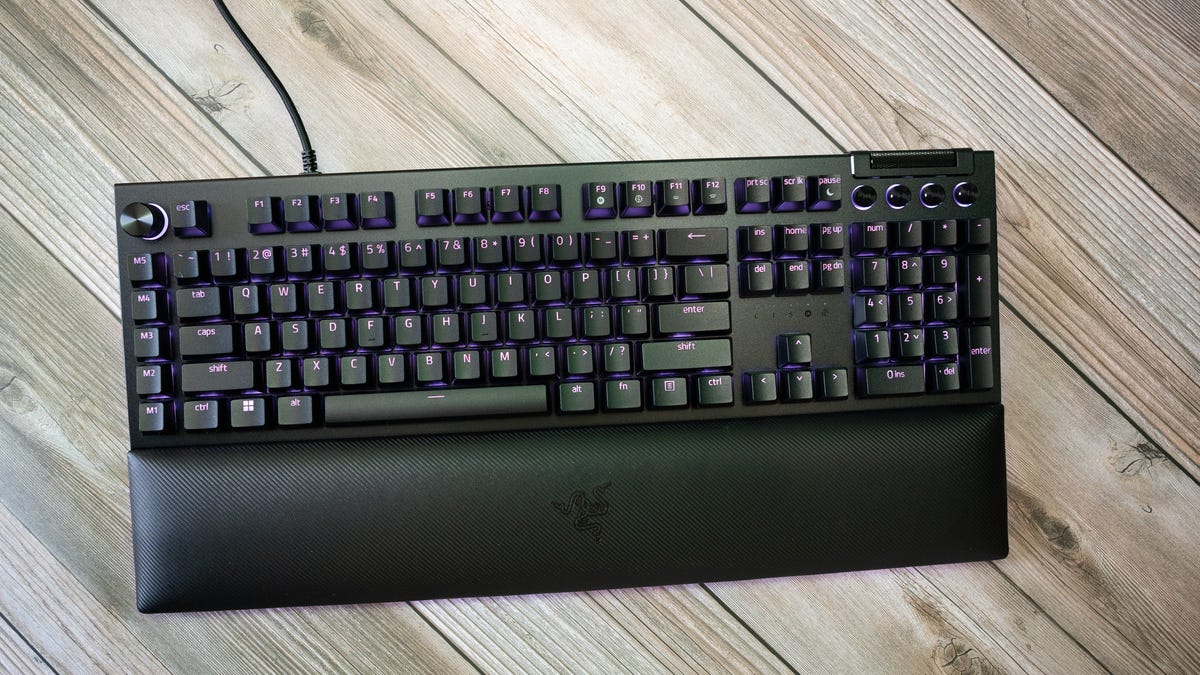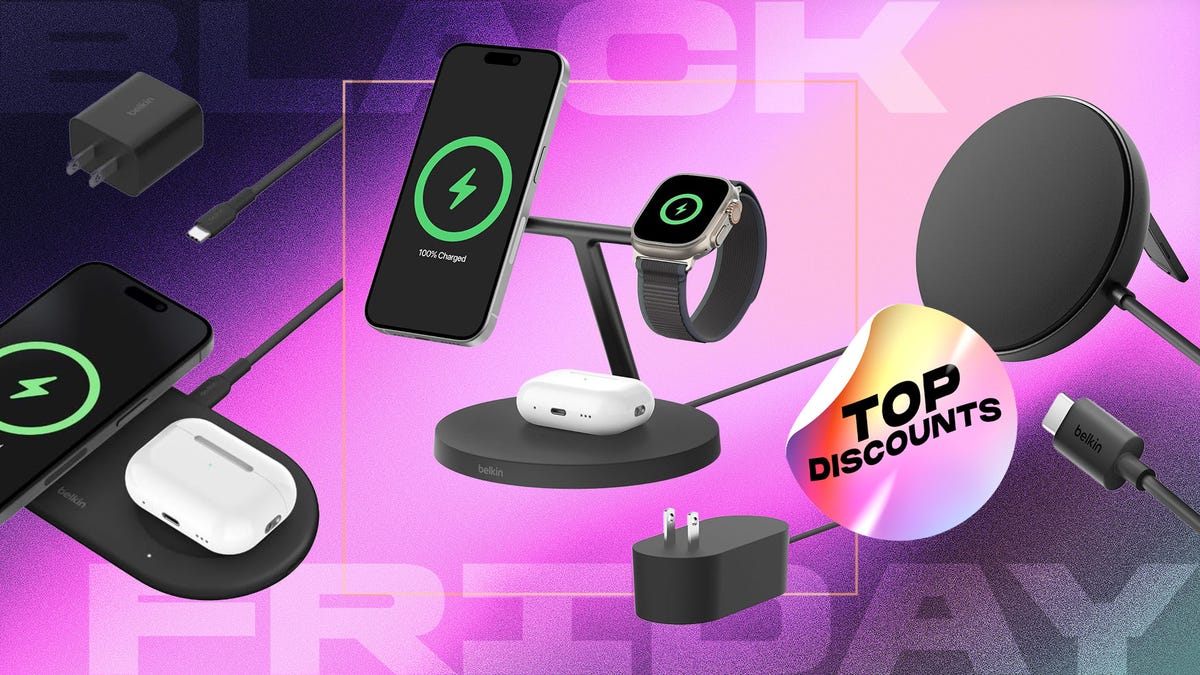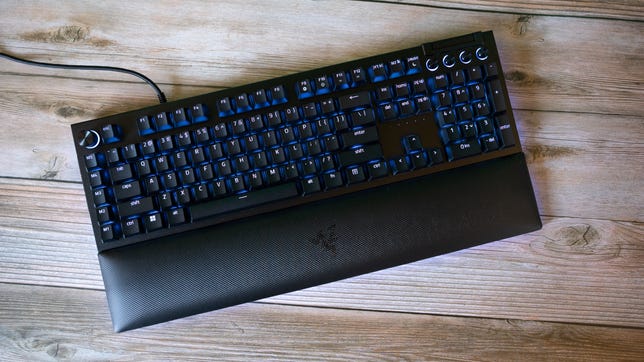Technologies
Razer BlackWidow V4 Pro Review: A Lot of Choice in a Big Package
Razer’s latest iteration of its function-rules gaming keyboard atones for some sins of the past and adds some new tricks.

Razer’s customizing-comes-first mechanical gaming keyboard line, BlackWidow, hits its fourth generation with the BlackWidow V4 Pro, a $230 full-size model with some notable improvements over its predecessor. These improvements include expanded lighting, more programmable controls, USB passthrough and an improved wrist rest design. These are all notable updates; but while I welcome all the changes in spirit, I’m not thrilled with the execution in a few cases.
Nothing has changed in its fundamental keyboard aspects, with the exception of a boost of the maximum polling rate to 8,000Hz, something I’m not sure you really need here. The switches and keycaps remain the same: You have a choice of the latest generation of Razer’s tactile Green or linear Yellow switches and Razer’s durable DoubleShot ABS keycaps.
Like
- Expanded lighting zones
- More programmable controls
- Vastly improved magnetically attachable wrist rest
- Added USB passthrough
Don’t Like
- Buttons on left side are really easy to hit accidentally
- multicontroller roller is too low relative to the height of the keys
There are a lot more lighting zones thanks to the addition of underglow strips on the left and right, plus a front strip on the wrist rest, five new backlit macro keys down the left side and a new programmable control dial in the upper left corner.
Razer says it’s added lenses to the individual backlight LEDs, which does seem to improve the focus in particular directions. I also think it’s made a difference in the number of perceptible brightness levels — if you need that level of granularity. I wish you could take advantage of that by controlling the brightness levels for individual or groups of keys the way you can control colors: That way the keys you need most frequently could be brighter as well as a different color, but not completely dark.
The new control dial allows you to map zooming, scrolling and other customization to your profiles. For example, the mappings default to zoom, keyboard brightness, task switching and track jogging. That’s becoming a more common feature these days, and it’s a useful one that extends beyond gaming. The physical control is fine, if a bit hemmed in. The downside is there are no presets beyond the basics — usually these controls come with sets — which means it requires a lot of time-intensive setup for a control you may end up not using.
There are also three new switches on the left side. I love the idea, but not so much the execution. I constantly make microadjustments to the location of keyboards — a nervous tic when I’m not actively typing — and so I end up hitting them a lot. It doesn’t help that I’m also adjusting to avoiding the left-side macro keys when reaching for alt-tab, where my compensation means my ring and pinky fingers naturally fall on those switches. And they’re too easy to activate, which may probably be a more broadly applicable issue.
These aren’t really complaints, since it’s certainly not the first keyboard to put the macro keys down the left side, but if you’re used to other layouts your muscle memory might need some retraining.
Then there’s the redesigned multicontroller, the roller bar with a bank of five, tall, round buttons above the number pad. It’s similar to the design on other keyboards, but the location and elevation don’t work, at least for my hands. The keys are so tall, relative to it, that it’s awkward to use. And remapping the control dial to do the same things, like adjust audio volume, isn’t quite as convenient, since you have to press it to cycle through the different mappings.
Like a lot of the programmability, you have to be running Razer’s Synapse utility for your customizations to work; you can’t save a lot of them to the internal keyboard memory. On the other hand, when you cycle through the mappings for the control dial there’s a popup telling you what the setting is and what the rotation does. There’s also a backlight color attached to each mapping but it’s not persistent, so you don’t know which setting the dial is currently mapped to with a glance.
The USB passthrough is a nice-to-have, and the new wrist rest is a lot more comfortable than the old one, plus it now attaches — pretty strongly — to the keyboard. If you’re sensitive to textures in a «I wear my shirts inside out because the seams make me crazy» kind of way, the bumpy faux leather may bother you, though.
It’s still big and heavy, but solidity in a keyboard isn’t something to complain about. Razer has upped the switch rating to 100 million keypresses, but they’re the same switches as before — they’ve just been tested more. I don’t put a lot of stock in durability ratings, but it’s nice to know that pounding on the keys won’t kill them any faster than it used to.
I’ve been using optomechanical switches for so long — and, more recently, linear ones — that going back to the feel of the tactile mechanicals has required some adjustment. But it’s nice to know that my fingers won’t accidentally trigger strokes if I rest them on the keys. That’s one of the perks that I miss with other types of switches.
For games where fast keyboard combos you can program are more important than single-key quick responsiveness, the BlackWidow V4 Pro makes a lot of sense. But unless you’re on board with how all the controls work, $230 might feel too expensive for your needs.
Technologies
Adorn Your Wrist With a 45mm Pixel Watch 3 for Just $200 This Black Friday
Both Amazon and Walmart are selling Google’s Pixel Watch 3 for just $200, but for how long?
There are tons of reasons to pick up a new smartwatch, not the least of which is monitoring your health and tracking your fitness goals. If you’re in the Android world, there are plenty of options to choose from right now. The Pixel Watch 3 is a solid choice, and it was our favorite Android smartwatch until the new Pixel Watch 4 took its place in the lineup. But the Watch 3 still boasts some great features that can help you stay on top of your wellness goals into the new year as well. And both Amazon and Walmart are running Black Friday deals that make it significantly cheaper than the Pixel Watch 4.
Both retailers are selling the bigger 45mm model with a solid $100 discount, so you can pick one up for just $200. That’s $100 less than the Pixel Watch 4’s Black Friday price. Again, this offer is available at both Walmart and Amazon, so take your pick as to where you place your order. Just do it soon because we don’t know how long these Black Friday deals will last.
The impressive watch was previously our top Android smartwatch because of its attractive design, large screen and speedy charging. It no longer requires a Fitbit Premium membership to access your readiness score, and it has plenty of great tools for runners. However, although the watch comes with Google Assistant, it doesn’t include Gemini, Google’s AI.
Lisa Eadicicco, a former senior editor, said in her CNET review, «The Pixel Watch 3’s upgrades are enough to keep it as my top pick for a general-purpose Android smartwatch. If you’re anything like me and consider yourself a casual runner in need of a general-purpose Android watch that’s sleek and comfortable, the Pixel Watch 3 won’t disappoint.»
If this isn’t the Pixel Watch for you, take a look at our full roundup on the best Pixel Watch deals going on right now.
SMARTWATCH DEALS OF THE WEEK
-
$339 (save $60)
-
$280 (save $70)
-
$300 (save $50)
-
$150 (save $100)
-
$49 (save $30)
Why this deal matters
Google Watches don’t go on sale often. These rare discounts on the Pixel Watch 3 are thanks to the release of the Pixel Watch 4 earlier this year. This deal drops the 45mm model to just $200 — a new all-time low, and a strong value for one of the most versatile Android smartwatches available.
Don’t miss any of our unbiased tech content and lab-based reviews. Add CNET as a preferred Google source.
Join Our Daily Deals Text Group!
Get hand-picked deals from CNET shopping experts straight to your phone.
By signing up, you confirm you are 16+ and agree to receive recurring marketing messages at the phone number provided. Consent is not a condition of purchase. Reply STOP to unsubscribe. Msg & data rates may apply. View our Privacy Policy and Terms of Use.
Technologies
I Regularly Buy Belkin Gear at Full Price, but You Can Save Up to 63% for Black Friday
Belkin makes excellent mobile accessories, from cables to wireless charging stands. Snag some of our favorites for less this Black Friday.

You can never have too many charging options, especially when you can stock up during an epic sale. We’re just hours away from Black Friday, and Belkin is offering up to 65% off its mobile accessories at Amazon. Belkin regularly shows up in our best lists, including our roundup of top wireless chargers.
The brand makes excellent gear at reasonable prices, and those prices just got even lower. Whether you’re looking for a charging station for your nightstand or a sleek power bank for travel days, there’s a Belkin Black Friday deal for you.
The Belkin MagSafe three-in-one wireless charging stand landed on our list of best wireless chargers for its impressive fast-charging performance. Our expert, David Carnoy, praised the stand’s convenient design and its ability to fast charge Apple’s entire ecosystem. That means you’ll be able to charge your iPhone, Apple Watch and any AirPods with a wireless charging case — all at once. Carnoy’s only complaint was the price; however, it’s substantially discounted for Black Friday. Belkin’s MagSafe three-in-one wireless charging stand is now just $78 — 35% off the usual $120 price.
If you spend a lot of time in your car, be it a long commute or regular road trips, a good car mount is a must. The Belkin MagSafe car mount is another one of our favorite accessories. The magnets provide a strong, secure hold for your phone, and you can rotate it for easy access. The mount plus charger is currently available for $55, down from $80.
Speaking of road trips, if you’re traveling this holiday season, you definitely need a portable power bank. Belkin has a 10,000 mAh power bank with a built-in USB-C power delivery cable for $15. This 20-watt charger typically retails for $40, so you’re saving 63%. There are four colors, but this price only applies to the black model. Other colors are available for $30.
If you’ve got a Nintendo Switch 2 or you’re gifting it to a loved one, you’ll love Belkin’s Switch 2 travel case. It’s lightweight with a hard shell and has storage pockets for up to 12 game cards. Snag one right now for $22. Just make sure you click the on-page coupon to get the full discount.
Belkin also has huge discounts on headphones and earbuds if those are on your gift list this year.
Why this deal matters
Phone accessories, including chargers and earbuds, can wear quickly and are easy to lose. Third-party retailers like Belkin offer a solid selection of mobile accessories for all budgets. This Black Friday deal makes now an excellent time to shop with up to 63% off top-rated charging stations, car mounts and even headphones.
Join Our Daily Deals Text Group!
Get hand-picked deals from CNET shopping experts straight to your phone.
By signing up, you confirm you are 16+ and agree to receive recurring marketing messages at the phone number provided. Consent is not a condition of purchase. Reply STOP to unsubscribe. Msg & data rates may apply. View our Privacy Policy and Terms of Use.
Technologies
The Black Friday Gaming Deals You Want Are Already Here, Including PlayStation, Xbox and Alienware
-

 Technologies3 года ago
Technologies3 года agoTech Companies Need to Be Held Accountable for Security, Experts Say
-

 Technologies3 года ago
Technologies3 года agoBest Handheld Game Console in 2023
-

 Technologies3 года ago
Technologies3 года agoTighten Up Your VR Game With the Best Head Straps for Quest 2
-

 Technologies4 года ago
Technologies4 года agoBlack Friday 2021: The best deals on TVs, headphones, kitchenware, and more
-

 Technologies4 года ago
Technologies4 года agoVerum, Wickr and Threema: next generation secured messengers
-

 Technologies4 года ago
Technologies4 года agoGoogle to require vaccinations as Silicon Valley rethinks return-to-office policies
-

 Technologies4 года ago
Technologies4 года agoOlivia Harlan Dekker for Verum Messenger
-

 Technologies4 года ago
Technologies4 года agoiPhone 13 event: How to watch Apple’s big announcement tomorrow

